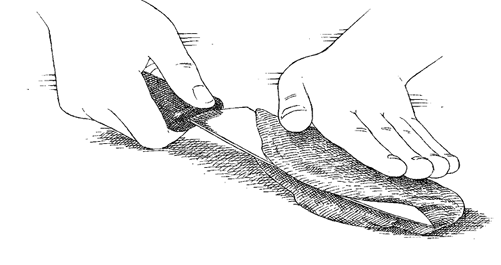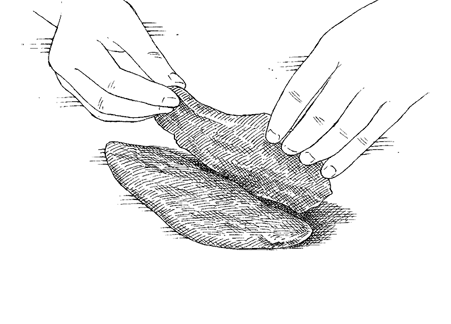Read The Cook's Illustrated Cookbook Online
Authors: The Editors at America's Test Kitchen
Tags: #Cooking
The Cook's Illustrated Cookbook (140 page)


![]() WHY THIS RECIPE WORKS
WHY THIS RECIPE WORKS
Sautéed chicken cutlets topped with a flavorful pan sauce are quick and easy to prepare. But while the chicken is lean, the sauces themselves are not—classic French pan sauces typically call for a generous amount of butter. We wanted a lighter, less rich sauce for our chicken that would still take advantage of the fond left in the skillet for serious flavor. We followed the usual steps for preparing a pan sauce—sautéing aromatics in the empty skillet, adding liquid and scraping up the browned bits from the bottom of the pan, simmering to concentrate flavors, and finally finishing the sauce with cold butter. But adding just a teaspoon of flour to the aromatics as a thickener was a simple step that allowed us to cut back substantially on the butter (to just 1 tablespoon). Cutting back on the butter had the added benefit of allowing the other flavors (in this case, lemon, capers, and parsley) to take center stage.
See “SLICING CHICKEN BREASTS INTO CUTLETS” illustrations that follow recipe.
SERVES 4
To make slicing the chicken easier, freeze it for 15 minutes. More pan sauce recipes follow.
CHICKEN
4 | (6- to 8-ounce) boneless, skinless chicken breasts, tenderloins removed, trimmed |
Salt and pepper | |
2 | tablespoons vegetable oil |
LEMON-CAPER PAN SAUCE
2 | teaspoons vegetable oil |
1 | shallot, minced |
1 | teaspoon all-purpose flour |
³⁄ | cup low-sodium chicken broth |
1 | tablespoon capers, rinsed and chopped |
1 | tablespoon chopped fresh parsley |
1 | tablespoon unsalted butter, chilled |
2 | teaspoons lemon juice |
Salt and pepper |
1. FOR THE CHICKEN:
Adjust oven rack to middle position and heat oven to 200 degrees. Halve chicken horizontally, then cover chicken halves with plastic wrap and pound to even ¹⁄
4
-inch thickness with meat pounder. Pat chicken dry with paper towels and season with salt and pepper.
2.
Heat 1 tablespoon oil in 12-inch skillet over medium-high heat until just smoking. Place 4 cutlets in skillet and cook until browned on first side, about 2 minutes. Flip cutlets and continue to cook until second side is opaque, 15 to 20 seconds; transfer to large ovensafe platter. Repeat with remaining 1 tablespoon oil and remaining 4 cutlets; transfer to platter. Tent loosely with aluminum foil and transfer to oven to keep warm while preparing sauce.
3. FOR THE PAN SAUCE:
Heat oil in now-empty skillet over low heat until shimmering. Add shallot and cook, stirring often, until softened, about 2 minutes. Add flour and cook, stirring constantly, for 30 seconds. Slowly whisk in broth, scraping up any browned bits. Bring to simmer and cook until reduced to ¹⁄
2
cup, 2 to 3 minutes. Stir in any accumulated chicken juices; return to simmer and cook for 30 seconds. Off heat, whisk in capers, parsley, butter, and lemon juice. Season with salt and pepper to taste. Pour sauce over chicken and serve immediately.
WHY WE’RE FOND OF FOND
Ever wonder how restaurants make rich sauces to accompany sautéed cutlets and steaks? Chances are it’s a pan sauce, made with the delicious caramelized browned bits (called fond) that sit on the bottom of the pan after the meat has been sautéed or pan-seared.
Pan sauces are usually made by adding liquid (broth, wine, or juice) to the pan once the cooked cutlets or steaks have been transferred to a plate to rest. The liquid dissolves the fond (a process known as deglazing) and incorporates it into the sauce.
So what makes those browned bits so flavorful and so valuable? When meat or chicken browns, a process called the Maillard reaction occurs. This process is named after the French chemist who first described this reaction about 100 years ago. When the amino acids (or protein components) and natural sugars in meat are subjected to intense heat, like that found in a skillet, they begin to combine and form new compounds. These compounds in turn break down and form yet more new flavor compounds, and so on and so on, like rabbits multiplying. The browned bits left in the pan once the meat has been cooked are packed with complex flavors, which are carried over to the pan sauce once the fond has been dissolved. And fond isn’t useful only for pan sauces—we also rely on fond to flavor braises, as well as other dishes where meat is browned, such as soups and stews.
MAKES ENOUGH FOR 1 RECIPE
SAUTÉED CHICKEN CUTLETS
2 | teaspoons vegetable oil |
1 | leek, white and light green parts only, halved lengthwise, sliced ¹⁄ |
1 | teaspoon all-purpose flour |
³⁄ | cup low-sodium chicken broth |
¹⁄ | cup dry vermouth or dry white wine |
1 | tablespoon unsalted butter, chilled |
2 | teaspoons chopped fresh tarragon |
1 | teaspoon whole grain mustard |
Salt and pepper |
Heat oil in now-empty skillet over medium heat until shimmering. Add leek and cook, stirring often, until softened and lightly browned, about 5 minutes. Add flour and cook, stirring constantly, for 30 seconds. Slowly whisk in broth and vermouth, scraping up any browned bits. Bring to simmer and cook until reduced to ³⁄
4
cup, 3 to 5 minutes. Stir in any accumulated chicken juices; return to simmer and cook for 30 seconds. Off heat, whisk in butter, tarragon, and mustard. Season with salt and pepper to taste. Pour sauce over chicken and serve immediately.
MAKES ENOUGH FOR 1 RECIPE
SAUTÉED CHICKEN CUTLETS
2 | teaspoons vegetable oil |
3 | garlic cloves, minced |
1 | teaspoon all-purpose flour |
¹⁄ | teaspoon paprika |
³⁄ | cup low-sodium chicken broth |
¹⁄ | cup plus 1 teaspoon dry sherry |
¹⁄ | cup jarred roasted red peppers, patted dry and cut into ¹⁄ |
1 | tablespoon unsalted butter, chilled |
¹⁄ | teaspoon chopped fresh thyme |
Salt and pepper |
Heat oil and garlic in now-empty skillet over low heat. Cook, stirring often, until garlic turns golden but not brown, about 1 minute. Add flour and paprika and cook, stirring constantly, for 30 seconds. Slowly whisk in broth and ¹⁄
2
cup sherry, scraping up any browned bits. Bring to simmer and cook until reduced to ³⁄
4
cup, 3 to 5 minutes. Stir in any accumulated chicken juices; return to simmer and cook for 30 seconds. Off heat, whisk in peppers, butter, thyme, and remaining 1 teaspoon sherry. Season with salt and pepper to taste. Pour sauce over chicken and serve immediately.
MAKES ENOUGH FOR 1 RECIPE
SAUTÉED CHICKEN CUTLETS
Be sure to add the broth to the skillet before adding the brandy.
2 | teaspoons vegetable oil |
1 | shallot, minced |
1 | teaspoon all-purpose flour |
³⁄ | cup low-sodium chicken broth |
¹⁄ | cup plus 1 tablespoon brandy |
2 | tablespoons heavy cream |
2 | tablespoons chopped fresh chives |
2 | teaspoons lemon juice |
1 | teaspoon Dijon mustard |
Salt and pepper |
Heat oil in now-empty skillet over low heat until shimmering. Add shallot and cook, stirring often, until softened, about 2 minutes. Add flour and cook, stirring constantly, for 30 seconds. Slowly whisk in broth, then ¹⁄
4
cup brandy, scraping up any browned bits. Bring to simmer and cook until reduced to ¹⁄
2
cup, 2 to 3 minutes. Stir in cream and any accumulated chicken juices; return to simmer and cook until thickened, about 1 minute. Off heat, whisk in chives, lemon juice, mustard, and remaining 1 tablespoon brandy. Season with salt and pepper to taste. Pour sauce over chicken and serve immediately.
Cutlets are about half the thickness of boneless, skinless breasts and are called for in many recipes. Rather than buy them already cut, we prefer to make them ourselves—store-bought cutlets are often ragged and they vary widely in size and thickness.

1.
Lay chicken breast flat on cutting board, smooth side facing up. Rest 1 hand on top of chicken and, using sharp chef’s knife, carefully slice chicken in half horizontally.

2.
This will yield 2 thin cutlets between ¹⁄
4
and ¹⁄
2
inch thick.
